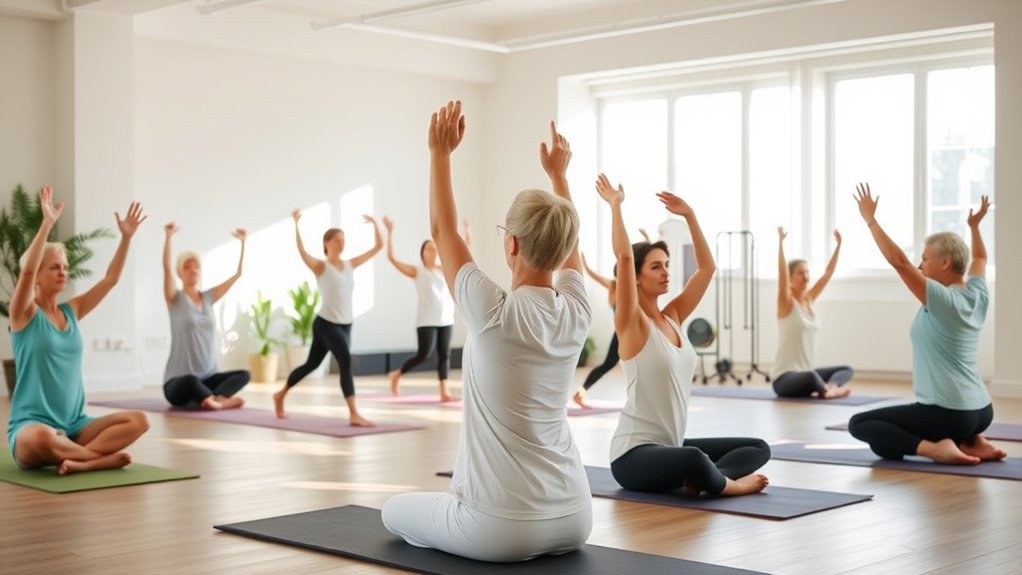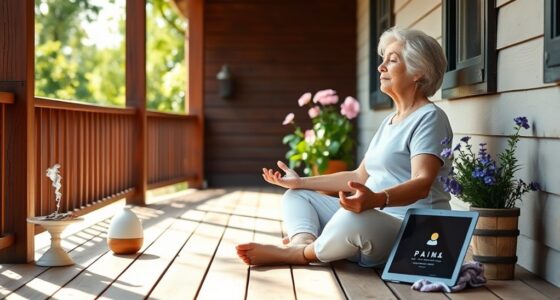To preserve joint mobility with low-impact workouts, you can walk, swim, cycle, or dance, which all boost flexibility while protecting your joints. Practices like yoga and Pilates improve balance and range of motion, while resistance bands and chair exercises strengthen muscles gently. Stretching routines help reduce stiffness, ensuring your joints stay healthy. Keep exploring different activities and tips to stay active and maintain your joint health effectively.
Key Takeaways
- Incorporate walking, swimming, cycling, or dancing to boost cardiovascular health with minimal joint stress.
- Use water-based exercises like water aerobics for gentle resistance and increased flexibility.
- Practice yoga or tai chi regularly to enhance joint lubrication, flexibility, and balance.
- Engage in resistance band or chair exercises to strengthen muscles supporting joints without high impact.
- Prioritize regular stretching and gentle movements to maintain joint range of motion and prevent stiffness.
Walking: A Simple and Effective Low-Impact Cardio
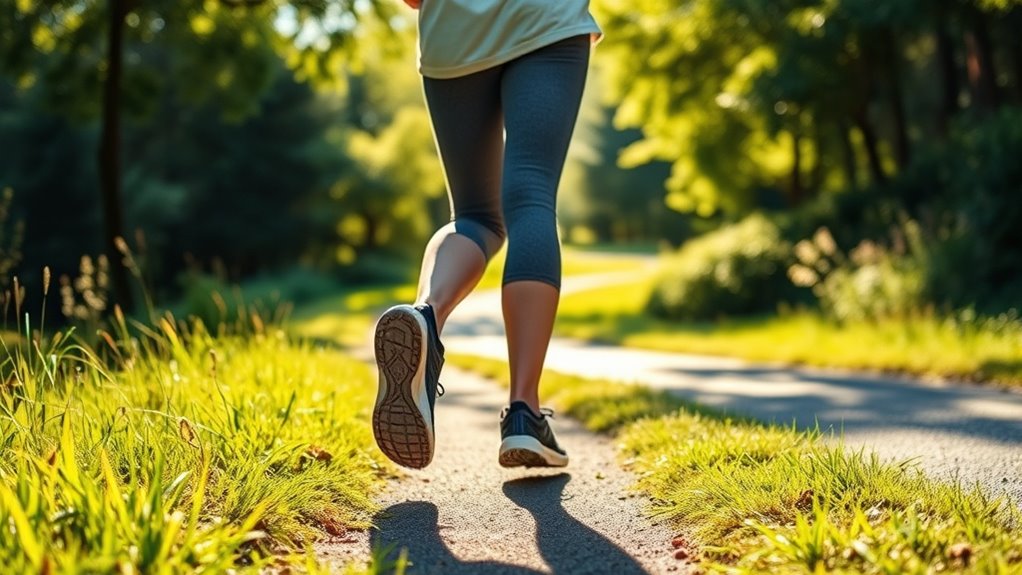
Walking is one of the easiest and most accessible low-impact cardio workouts you can do. It requires no special equipment, just a comfortable pair of shoes, and can be done almost anywhere. Walking helps improve your cardiovascular health, boost your mood, and increase stamina without putting stress on your joints. You can walk at a pace that suits your fitness level, whether briskly or leisurely. Regular walking strengthens muscles around your knees and hips, providing better support and stability. It’s easy to incorporate into daily routines—whether during lunch breaks, errands, or evening strolls. Plus, walking is gentle enough to do daily, making it an ideal low-impact exercise for maintaining joint mobility and overall health. Incorporating proper technique and posture during your walks can further reduce strain and enhance benefits. Maintaining good body alignment can help prevent discomfort and maximize the effectiveness of your walk. Additionally, personalized advice from fitness professionals can guide you in optimizing your walking routine for better joint health. Water park resorts often feature scenic walking paths and outdoor areas perfect for low-impact exercise in a fun environment. Being mindful of joint safety can also help prevent injuries and ensure a sustainable exercise routine.
Swimming and Water Aerobics for Joint-Friendly Exercise
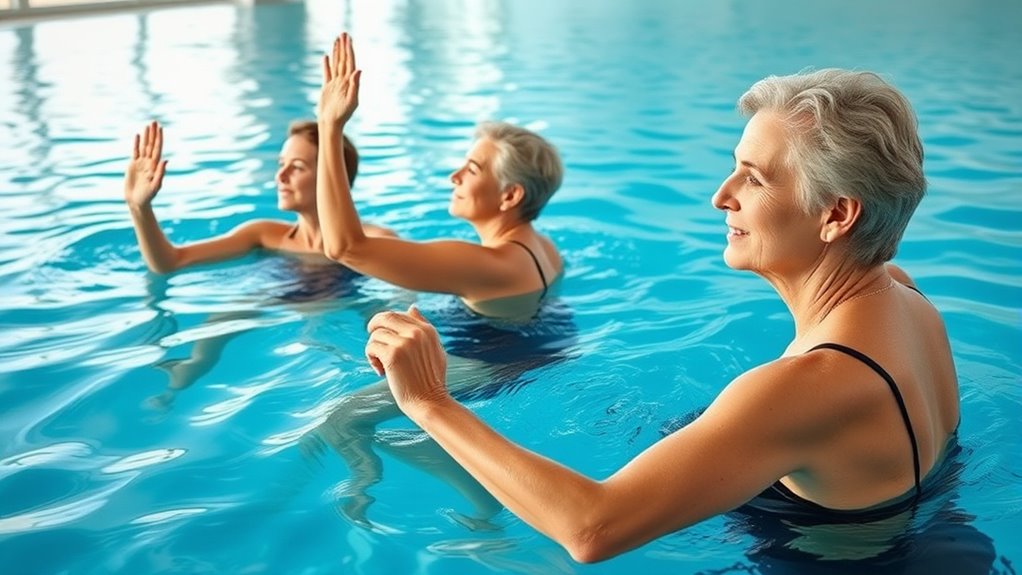
Swimming and water aerobics provide gentle resistance that helps strengthen muscles without stressing your joints. The water’s buoyancy reduces impact, making these activities easier on your body. This combination supports improved flexibility and joint health while giving you an effective workout. Additionally, incorporating joint-friendly exercises can further enhance your routine to suit your needs. Engaging in activities that promote joint preservation can help maintain mobility and prevent stiffness over time. Using water-based workouts also promotes healthy joint function, which is essential for long-term mobility.
Gentle Resistance and Flexibility
Have you ever considered how water-based exercises can provide gentle resistance while supporting your joints? Water’s natural resistance helps strengthen muscles without strain, making it ideal for flexibility. When you move through water, your muscles work more efficiently, promoting joint stability. Plus, water’s buoyancy reduces impact, so you can stretch and strengthen safely. Incorporate simple movements like arm circles or leg lifts to improve flexibility. Water aerobics classes often include resistance exercises using water weights or noodles, adding gentle strength training. These workouts can help maintain or increase joint range of motion, essential for daily activities. Enjoy the soothing sensation of water as you improve flexibility and build strength without risking joint discomfort or injury.
- Use water resistance for muscle engagement
- Focus on slow, controlled movements
- Incorporate stretching exercises
- Use water weights or noodles
- Practice consistent, gentle routines
Reduced Impact Benefits
Did you know that swimming and water aerobics offer exceptional low-impact exercise options that protect your joints? These activities reduce stress on your bones and cartilage while still providing effective cardiovascular and strength benefits. Water supports your body, minimizing the risk of injury and joint strain. Plus, the resistance of water helps tone muscles without harsh impacts. Here’s a quick look at the benefits:
| Benefit | How It Helps | Why It’s Ideal |
|---|---|---|
| Reduced joint stress | Water buoyancy lessens weight on joints | Perfect for arthritis or injury recovery |
| Improved flexibility | Gentle movements promote range of motion | Suitable for all fitness levels |
| Enhanced circulation | Water resistance boosts blood flow | Supports joint health |
| Muscle strengthening | Resistance training without impact | Builds strength safely |
| Cardiovascular health | Aerobic exercises in water | Maintains heart health with low impact |
Cycling: Gentle Pedaling for Strength and Mobility
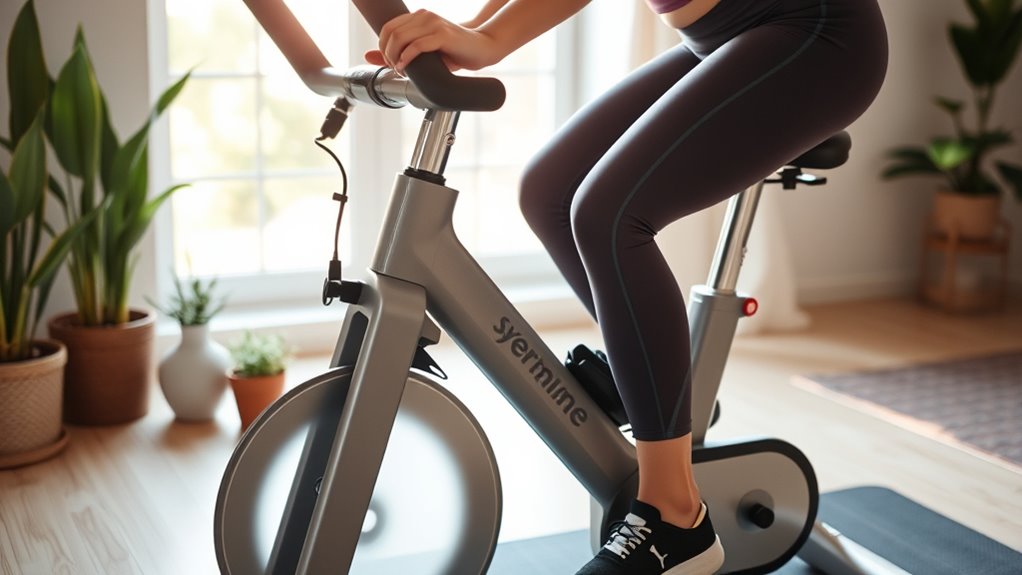
Cycling at a gentle pace is an excellent low-impact workout that boosts both strength and mobility without putting too much strain on your joints. It helps improve cardiovascular health, enhances leg muscle endurance, and promotes joint flexibility. Plus, it’s easy to do indoors or outdoors, making it accessible regardless of your fitness level. As you pedal slowly, you activate muscles gently, which supports joint health and reduces stiffness. To make the most of your cycling session, consider these tips:
- Maintain proper seat height for comfortable pedaling
- Use a bike with cushioned grips or ergonomic design
- Keep your cadence steady and moderate
- Incorporate short rides into your daily routine
- Stretch your legs before and after cycling to prevent stiffness
Enjoy the smooth motion and gentle exercise that cycling provides!
Yoga: Enhancing Flexibility and Joint Health
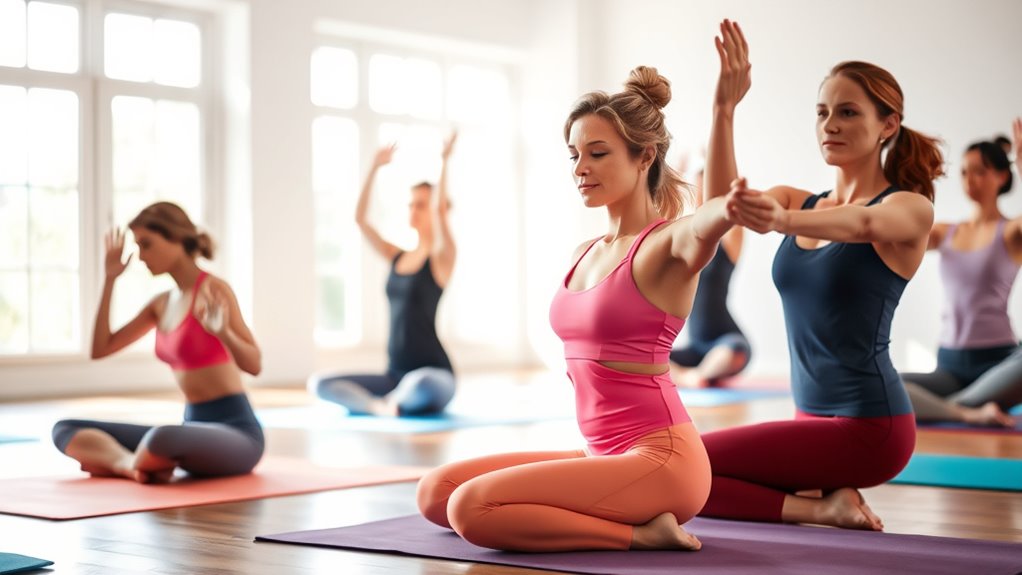
Yoga uses gentle stretching techniques that help increase your flexibility and joint mobility. As you practice regularly, you’ll notice an improved range of motion and less stiffness. These simple movements make a big difference in maintaining joint health over time. Embracing a creative practice like yoga encourages risk-taking and experimentation, which can lead to greater resilience and innovation in your physical health routines.
Gentle Stretching Techniques
Gentle stretching techniques, such as those found in yoga, are effective ways to improve flexibility and support joint health without putting excessive strain on your body. These stretches help release tension, increase blood flow, and maintain joint mobility. By practicing regularly, you can reduce stiffness and prevent injuries, all while avoiding high-impact movements. Focus on slow, controlled motions that target major muscle groups and joints. Remember to breathe deeply and listen to your body, stopping if you feel discomfort. Incorporating gentle stretches into your routine is easy and adaptable, making it suitable for all fitness levels. Consistency is key to experiencing lasting benefits and keeping your joints healthy long-term.
- Focus on deep, steady breathing
- Hold each stretch for 15-30 seconds
- Avoid bouncing or quick movements
- Stretch both sides equally
- Combine with mindful breathing for relaxation
Improves Range of Motion
Are you looking to boost your joint flexibility and move more freely? Practicing yoga can considerably improve your range of motion. By regularly holding gentle poses and stretches, you gently lengthen muscles and loosen joints, making everyday movements easier. Yoga encourages controlled breathing and mindful movement, helping you relax tight muscles that limit mobility. As you progress, you’ll notice increased fluidity in your joints, reducing stiffness and enhancing overall flexibility. This improved range of motion allows you to perform daily activities with less effort and discomfort. Consistent practice also promotes better posture and alignment, further supporting joint health. Incorporating yoga into your routine offers a low-impact way to enhance mobility and keep your joints healthy and functional over time.
Reduces Joint Stiffness
Practicing yoga regularly can markedly reduce joint stiffness by promoting the flow of synovial fluid, which lubricates your joints and enhances their mobility. When you hold gentle poses, your joints stay active, preventing them from becoming stiff or restricted. Yoga also stretches surrounding muscles and tissues, easing tension that can contribute to stiffness. As you deepen your practice, you’ll notice increased flexibility and improved joint comfort. Consistent movement helps maintain cartilage health and reduces inflammation, making daily activities easier. By dedicating time to yoga, you actively support your joint health and prevent stiffness from setting in. Keep practicing regularly to enjoy long-term benefits and keep your joints flexible and pain-free.
- Improves circulation around joints
- Enhances tissue elasticity
- Promotes better posture
- Reduces muscle tightness
- Supports overall joint health
Pilates: Building Core Stability With Low Impact

Have you ever wondered how to strengthen your core without putting stress on your joints? Pilates offers a low-impact way to build stability, focusing on controlled movements that engage your deep abdominal muscles. Imagine lying on a mat, gently lifting your pelvis, or elongating your spine with precise breathing. To visualize the benefits, consider this table:
| Movement | Focus Area | Impact Level |
|---|---|---|
| Hundred | Core engagement | Low-impact |
| Roll-up | Spinal flexibility | Gentle |
| Leg circles | Hip and core stability | Minimal stress |
| Plank variations | Overall core strength | Soft on joints |
With consistent practice, you’ll notice improved posture, better balance, and less joint discomfort—all while protecting your joints. Additionally, the low-impact nature of Pilates is similar to the gentle but effective exercises used in joint preservation, making it especially suitable for those with joint concerns. Engaging in these low-impact workouts can also enhance your overall quality of life, especially as you age. Incorporating spiritual practices like Pilates can help maintain mobility without exacerbating joint issues. Furthermore, the mindful focus in Pilates promotes mind-body connection, supporting mental well-being alongside physical health.
Tai Chi: Gentle Movement for Balance and Joint Support
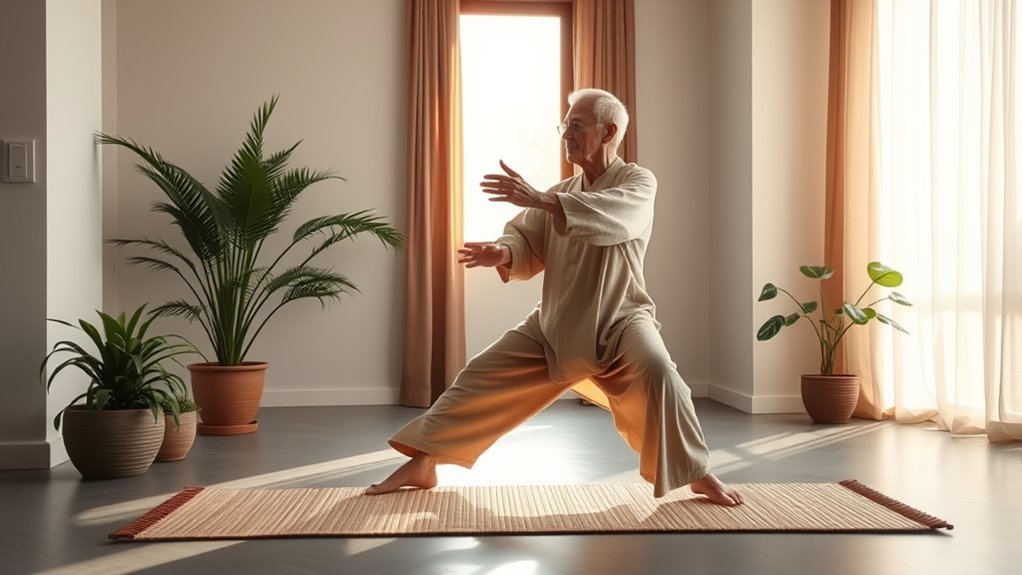
Tai Chi helps improve your balance and stability with slow, controlled movements. It also increases joint flexibility, making everyday motions easier and less painful. Plus, practicing Tai Chi reduces stress and tension, leaving you feeling more relaxed and centered. Additionally, incorporating mindful breathing techniques during practice enhances mental well-being and promotes overall relaxation. Regular practice can also support joint health by gently maintaining mobility and reducing stiffness over time. Engaging in consistent gentle exercise like Tai Chi can further strengthen muscles that support your joints, contributing to long-term joint preservation. Understanding the importance of preventive measures in maintaining joint health can motivate you to stay committed to your practice. Incorporating consistent physical activity such as Tai Chi is an effective way to promote joint longevity and overall vitality.
Enhances Balance and Stability
Because it involves slow, deliberate movements, Tai Chi effectively enhances your balance and stability. As you practice, you become more aware of your body’s positioning and improve your coordination. These gentle motions strengthen your core muscles, helping you maintain proper posture and prevent falls. Regular Tai Chi practice also trains your nervous system to respond quickly to shifts in weight, boosting your overall stability.
Enjoy these benefits:
- Improved proprioception and body awareness
- Reduced risk of falls and injuries
- Strengthened core and leg muscles
- Better coordination and control
- Increased confidence in daily movements
Promotes Joint Flexibility
Engaging in Tai Chi gently encourages joint flexibility by guiding your movements through a full range of motion. As you perform slow, deliberate sequences, your joints are encouraged to move smoothly without strain. This continuous, controlled motion helps improve elasticity in your joint tissues and maintains the natural lubrication that keeps your joints functioning well. Unlike high-impact exercises, Tai Chi minimizes stress on your joints while still promoting mobility. Regular practice allows your muscles and connective tissues around your joints to stretch gradually, increasing overall flexibility. Over time, you’ll notice greater ease in everyday movements and reduced stiffness. This gentle approach ensures you can enhance joint flexibility safely, supporting long-term joint health and reducing the risk of stiffness-related discomfort.
Reduces Stress and Tension
Practicing Tai Chi gently guides your body into slow, deliberate movements that effectively release built-up stress and tension. As you focus on your breath and movement, you’ll notice a calming sensation spreading through your muscles and mind. This mindful practice helps reduce anxiety, promotes relaxation, and clears mental clutter. The gentle flow encourages you to stay present, easing mental and physical strain. Over time, you’ll find yourself more centered, with greater emotional resilience. Integrating Tai Chi into your routine offers a peaceful escape from daily stressors, making it easier to maintain a balanced outlook. Enjoy these benefits as you cultivate calmness and reduce tension:
- Deepens breathing for relaxation
- Enhances mental clarity
- Releases muscle tightness
- Improves mood and emotional well-being
- Fosters a sense of inner peace
Resistance Band Workouts for Joint Preservation
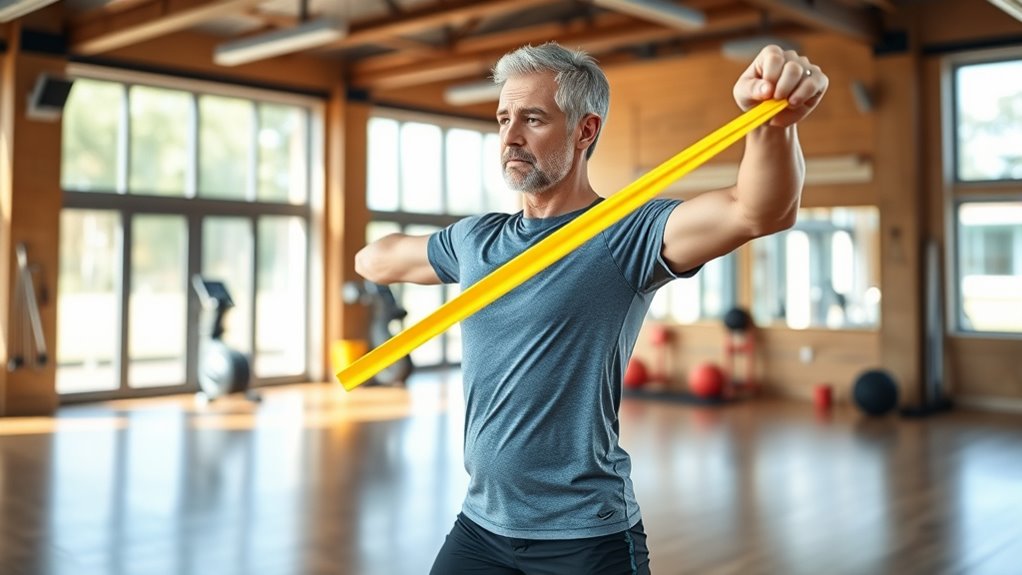
Resistance band workouts are an excellent low-impact option for preserving joint health while building strength. They provide gentle resistance that supports controlled movements, reducing strain on your joints. With bands, you can target specific muscle groups around your joints, improving stability and support. This helps prevent injuries and slows joint degeneration over time. You can easily adjust the resistance level to match your comfort and progress gradually. Incorporating resistance bands into your routine can enhance flexibility, improve circulation, and reduce stiffness. Their portability makes it simple to perform exercises anywhere, whether at home or on the go. Regular use strengthens muscles around your joints, helping to cushion and protect them during daily activities. Overall, resistance band workouts are effective and safe for maintaining joint function as you age.
Chair Exercises for Mobility and Strength

Chair exercises are a practical way to improve mobility and build strength, especially if you have limited movement or balance concerns. These exercises allow you to stay active safely while targeting key muscle groups. They can help reduce stiffness, improve posture, and boost your confidence in daily activities. You can perform chair exercises at home or in a community setting, making them accessible and convenient. Focus on slow, controlled movements to maximize benefits and prevent injury. Incorporating breathing techniques can also enhance relaxation and help you stay focused during your workout. Reap the benefits of consistent practice for noticeable improvements in joint comfort and overall strength. Remember, consistency is key to seeing results and maintaining mobility over time. Mindfulness practices can also enhance your focus and relaxation during exercise, promoting a more mindful movement experience. Being aware of joint health can guide you in choosing appropriate exercises and preventing strain.
Stretching Routines to Improve Flexibility and Reduce Stiffness
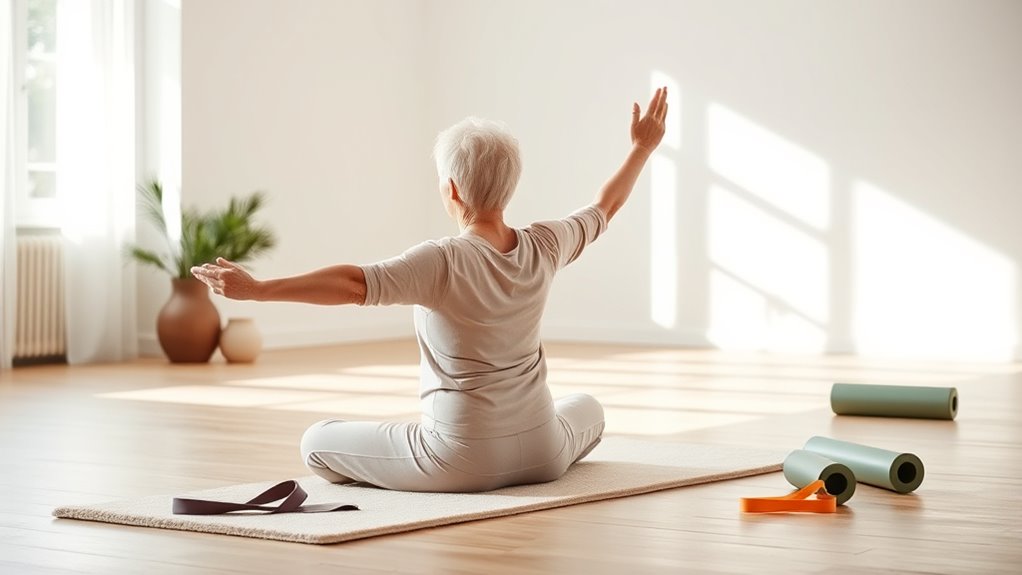
Building on the strength you develop through chair exercises, incorporating regular stretching routines can substantially enhance your flexibility and reduce stiffness. Focus on gentle, controlled stretches that target major muscle groups, such as hamstrings, calves, shoulders, and neck. Hold each stretch for 15 to 30 seconds, breathing deeply to relax muscles. Avoid bouncing or forcing movements, which can cause injury. Consistent stretching helps improve joint range of motion and decreases tightness, making daily activities easier. Incorporate stretches into your routine daily or at least several times a week for best results. Remember to listen to your body—never push into pain. Over time, these routines will help you feel more limber, reduce discomfort, and support overall joint health.
Dancing: Fun, Low-Impact Movement to Keep Joints Healthy
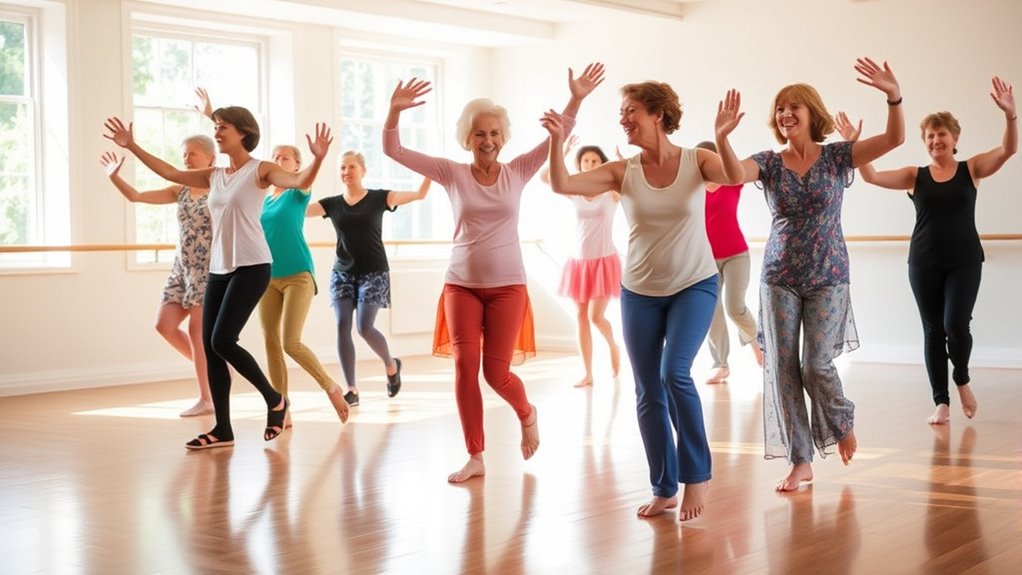
Dancing offers a joyful way to stay active without putting excessive strain on your joints. It combines movement, rhythm, and creativity, making exercise feel less like a chore. Whether you prefer slow ballroom steps or upbeat salsa, dancing helps improve flexibility, balance, and strength, all while being gentle on your joints. The social aspect can boost your mood and motivation, encouraging regular activity. You don’t need a dance studio—just a little space and your favorite music. Dancing can be tailored to your ability, gradually increasing intensity as your comfort grows. Plus, it’s easy to incorporate into daily life, making movement enjoyable rather than a workout. So, get moving with dance and keep your joints healthy with fun, low-impact exercise.
Dance joyfully to improve flexibility and strength while being gentle on your joints.
- Choose styles like ballroom or line dancing for gentle movement
- Incorporate basic steps to avoid overexertion
- Use music at a comfortable volume to motivate yourself
- Practice regularly for joint flexibility and strength
- Invite friends for added fun and accountability
Frequently Asked Questions
Can Low-Impact Workouts Effectively Improve Overall Joint Health?
You might wonder if low-impact workouts can truly boost your joint health. The good news is, they do help by reducing stress on your joints while strengthening muscles around them. Regularly engaging in activities like walking, swimming, or cycling increases flexibility and mobility. These workouts are especially beneficial if you’re recovering from injury or dealing with arthritis, as they promote joint preservation without overexertion.
How Often Should I Do Low-Impact Exercises for Best Results?
Imagine your joints as delicate gears that need gentle oiling to run smoothly. You should aim for low-impact exercises about three to five times a week, allowing your body time to recover and adapt. Consistency is key, so choose activities you enjoy and can sustain. This routine helps maintain flexibility and strength without overloading your joints, keeping you active and comfortable in the long run.
Are There Any Risks or Contraindications for Low-Impact Workouts?
When considering low-impact workouts, you might wonder about risks. Generally, these exercises are safe and gentle on your joints, but watch out for overexertion or improper form, which can cause strain or injury. If you have existing health issues or joint problems, consult your doctor before starting. Pay attention to your body, and stop if you experience pain or discomfort, ensuring a safe and effective workout.
Can Low-Impact Exercises Help With Arthritis Pain Management?
Oh, sure, doing less can actually do more—like easing arthritis pain. Low-impact exercises gently strengthen your muscles and improve joint flexibility without the jarring movements that worsen pain. You might find that these workouts reduce stiffness and increase mobility, making daily tasks easier. So, ironically, taking it slow and gentle could be your best strategy for managing arthritis discomfort while keeping your joints healthy.
How Do I Modify Exercises for Specific Joint Limitations?
You can modify exercises for your joint limitations by choosing low-impact options and adjusting movements to reduce strain. Focus on gentle stretches or controlled motions that don’t cause pain, and use support tools like resistance bands or chairs. Always listen to your body, avoid overextending, and consult a physical therapist for personalized modifications that protect your joints while keeping you active and safe.
Conclusion
By embracing these gentle activities, you’re nurturing your joints like delicate blossoms in spring. Each movement, from a graceful stretch to a peaceful swim, helps keep your mobility vibrant and resilient. Think of your joints as quiet rivers flowing smoothly, their paths clear and free. With consistent care and a touch of joy, you’ll allow your body’s natural harmony to flourish, guiding you gently toward a future of graceful, effortless movement.
